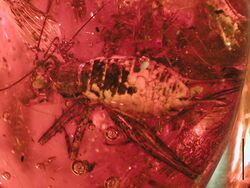Biology:Araneagryllus
| Araneagryllus | |
|---|---|

| |
| A. dylani holotype female | |
| Scientific classification | |
| Domain: | Eukaryota |
| Kingdom: | Animalia |
| Phylum: | Arthropoda |
| Class: | Insecta |
| Order: | Orthoptera |
| Suborder: | Ensifera |
| Family: | Phalangopsidae |
| Genus: | †Araneagryllus Heads, 2010 |
| Species: | †A. dylani
|
| Binomial name | |
| †Araneagryllus dylani Heads, 2010
| |
Araneagryllus is an extinct monotypic genus of cricket in the subfamily Phalangopsinae with the sole species Araneagryllus dylani.[1] The fossil was recovered in the Dominican Republic from early Miocene Burdigalian stage Dominican amber deposits on the island of Hispaniola.[1][2] Araneagryllus is the first Phalangopsinae cricket to be described from the fossil record.[1]
The genus is known from a single 12.11 millimetres (0.477 in) long female specimen, the holotype, currently deposited in the collections of the American Museum of Natural History in New York City , as number "DR-12-32", and which was first studied by Dr. Sam W. Heads.[1] Dr. Heads published his 2010 type description in the Zoological Journal of the Linnean Society volume number 158.[1] The genus name is a combination of the Latin aranea meaning "spider" and gryllus, meaning "cricket" in reference to the common name given the subfamily where Araneagryllus is placed.[1] The species name is in honor of Dylan L. Heads, son of Dr. Heads.[1] The female has a notable development of a white "emulsion" developed around the mouth parts and on the abdomen.[1]
Araneagryllus dylani possesses a wide shield-like, pronotum which has irregularly spaced setae and prominent ridges along the center and margins.[1] The legs are long with areas of short and long setae, and are marked with a pattern of dark marking ranging from spots on the profemur to stripes on the mesotibia.[1] The metatibia sports two rows of ten to twelve spines, four subapical spurs, and three apical spurs. The middle apical spur is notably longer than the other two spurs.[1] Both cerci the joint of one hind leg and the ovipositor are incomplete, having been removed during shaping and polishing of the amber specimen.[1] Cladistic analysis places Araneagryllus within a clade composed of Arachnopsita, Leptopedetes, Longuripes, Mayagryllus, Nemoricantor, and Prolonguripes. All seven genera, among other characters, possessing an elongated middle apical spur.[1]
References
- ↑ 1.00 1.01 1.02 1.03 1.04 1.05 1.06 1.07 1.08 1.09 1.10 1.11 1.12 Heads, S.W. (2010). "The first fossil spider cricket (Orthoptera: Gryllidae:Phalangopsinae): 20 million years of troglobiomorphosis or exaptation in the dark?". Zoological Journal of the Linnean Society 158 (1): 56–65. doi:10.1111/j.1096-3642.2009.00587.x.
- ↑ Iturralde-Vinent, M.A.; MacPhee, R.D.E. (1996). "Age and Paleogeographical Origin of Dominican Amber". Science 273 (5283): 1850–1852. doi:10.1126/science.273.5283.1850. Bibcode: 1996Sci...273.1850I.
Wikidata ☰ Q4784074 entry
 |

